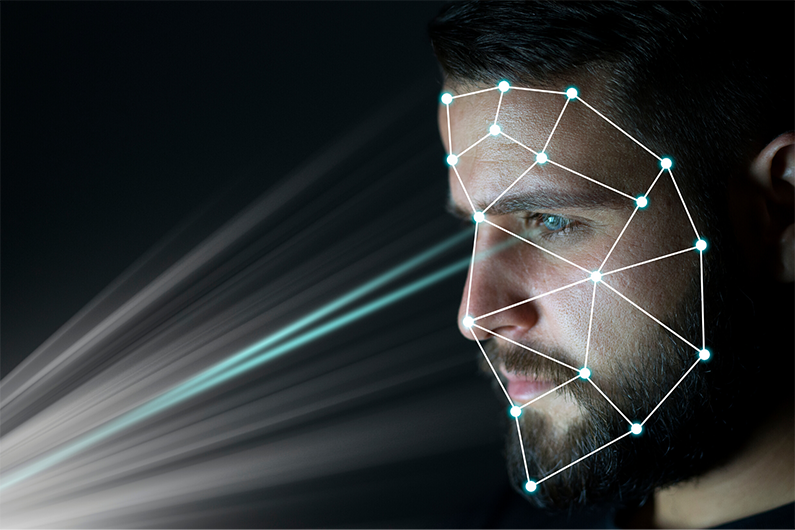In recent years the demand for solutions based on facial recognition technologies has increased sharply. Companies from different industries are implementing them to speed up processes and improve the user experience in such situations as the remote registration of new clients or access control. But, what is the history of this technology? What are the reasons behind its recent massive application? What is so special about a person’s face that it can be used as a key to access?
To answer these questions we will take a look at facial recognition’s history, from its origin to the present day.
What is facial recognition?
From a general point of view, facial recognition technology is based on the extraction by different means of biometric characteristics that have the power to distinguish between people. Each facial image is modelled with a series of numerical values that grouped together make up what is popularly known as a pattern of characteristics. These patterns can then be used to carry out different operations such as calculating the similarity between two faces (facial matching), identification between a set of people (biometric identification 1:N) or identity verification (if someone is really who they claim to be).
Recognition technologies based on facial biometrics have been widely accepted, mainly because of their robustness, reliability and low intrusiveness. A single image of the user is enough to carry out the whole process, with this technology being easily integrated into digital products where people’s identities need to be verified.
Who were the earliest pioneers of facial recognition?
The initial steps in facial recognition are attributed to Woodrow Wilson Bledsoe, a mathematician who developed an early prototype baed on the use of RAND tablets in the 1960s. This tablet allowed facial features to be recreated through coordinates with the help of a pencil that transmitted electromagnetic impulses to a grid.
With this device, Bledsoe was able to digitise people’s facial features, such as their eyes or mouth, and then store them in a database. By entering a new facial image into the system it was possible to select the closest of the previously saved images. Despite the fact that at that time the system had many shortcomings, it served to lay the foundations for the use of biometric technology in facial recognition.
Evolution of facial recognition
Following Bledsoe’s work, some advances appeared in the following years which improved the accuracy of the results. Some of the new approaches were based on the use of facial markers on specific areas of the face such as the corners of the mouth, eyes or nose, assuming that the description of their spatial position modelled relevant and powerful biometric patterns.
Nevertheless, the approaches based on anthropometric techniques did not achieve the expected results, thus for some years the research on facial recognition techniques did not benefit from much development. Probably the most important turning point came in 2001 when Paul Viola and Michael Jones proposed a framework for object detection that achieved success rates never seen before. Their algorithm was based on the combination of the use of fast computing features (HAAR features) with an optimised training process. In this way it was possible to detect the face quickly and reliably, and to isolate areas of the image in order to apply more powerful descriptors.
In recent years the most relevant advances in the field of face recognition have been made by the use of deep learning environments. Unlike classical methods (where the descriptors to be applied on the input image had to be chosen beforehand), deep learning algorithms through the learning process create their own feature extractors by analysing complex relationships between the input data set. The significant boost in computational power together with the immense amount of images available through the internet has allowed deep learning-based facial recognition systems to achieve very high success rates even in the most demanding environments.
What is facial biometry used for today?
Recognition based on facial biometrics is a technology with huge potential and numerous applications in different areas where it is necessary to verify the identity of people: access control, recognition of criminals, search for missing persons, unlocking of mobiles, digital onboarding…
Digital Onboarding has surged as companies wanted to digitize offline processes as well as provide a fully digital experience while speeding up remote registration process. Regulations (KYC and AML) have been put in place to protect the identity of customers through secure checks as well as to curb possible use for illegitimate purposes such as money laundering. Banks, insurance companies, online gaming and gambling companies, telco and retailers have found facial recognition to be a useful tool in streamlining initial registration and providing an extra layer of security to their systems.
At Mobbeel we develop tools that implement these procedures in a simple way: MobbScan (digital onboarding solution) and MobbID (biometric identity verification) can be your best allies in the digital transformation of your company.
If you are interested in learning more about how our facial recognition technology can help you verify your customers’ online identities, please do not hesitate to contact us!

I’m a Software Engineer with a passion for Marketing, Communication, and helping companies expand internationally—areas I’m currently focused on as CMO at Mobbeel. I’m a mix of many things, some good, some not so much… perfectly imperfect.

GUIDE
Identify your users through their face
In this analogue-digital duality, one of the processes that remains essential for ensuring security is identity verification through facial recognition. The face, being the mirror of the soul, provides a unique defence against fraud, adding reliability to the identification process.




